
The Cyperaceae are a family of graminoid (grass-like), monocotyledonous flowering plants known as sedges. The family is large, with some 5,500 known species described in about 90 genera, the largest being the "true sedges" genus Carex with over 2,000 species.

Rhynchospora is a genus of about 400 species of sedges with a cosmopolitan distribution. The genus includes both annual and perennial species, mostly with erect 3-sided stems and 3-ranked leaves. The achenes bear a beak-like tubercule and are sometimes subtended by bristles. Many of the species are similar in vegetative appearance, and mature fruits are needed to make a positive identification.

Eleocharis palustris, the common spike-rush, creeping spike-rush or marsh spike-rush, is a species of mat-forming perennial flowering plants in the sedge family Cyperaceae. It grows in wetlands in Europe, North Africa, northern and central Asia and North America. Eleocharis palustris is not easily distinguished from other closely related species and is extremely variable worldwide itself. The species epithet palustris is Latin for "of the marsh" and indicates its common habitat.

Rhynchospora tracyi, known by the common name of Tracy's beaksedge, is a member of the sedge family, Cyperaceae. It is a perennial herb, native to the Southeastern United States, the Bahamas, Cuba, Belize, and Honduras.

Rhynchospora corymbosa, known by the common names of golden beaksedge and matamat, is a member of the sedge family, Cyperaceae. It is a perennial herb, found globally throughout the tropics. It grows up to 2 meters tall in riverbanks, shallow pools, and swamps.

Rhynchospora rugosa, known by the common name of claybank beaksedge, is a member of the sedge family, Cyperaceae. It is a perennial herb, native to Central and South America.
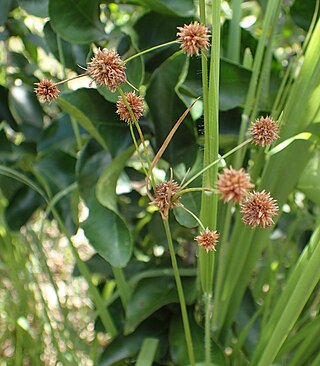
Rhynchospora holoschoenoides, known by the common name of fly beaksedge, is a member of the sedge family, Cyperaceae. It is a perennial herb, found throughout the Caribbean, Central and South America and western and southern Africa.

Rhynchospora riedeliana is a member of the sedge family, Cyperaceae. It is a perennial herb, native to the state of Minas Gerais in Brazil.
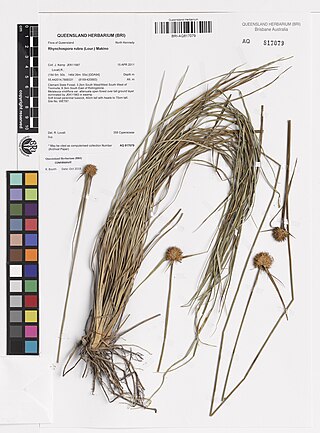
Rhynchospora rubra is a member of the sedge family, Cyperaceae. It found throughout southeast Asia, Oceania, and western and southern Africa.

Rhynchospora cephalotes is a member of the sedge family, Cyperaceae. It is a perennial herb, found throughout the tropics of Central and South America, from southern Mexico and western Cuba in the northern extreme to Bahia and Bolivia in the southern extreme.
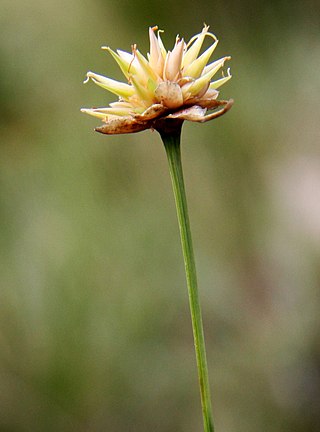
Rhynchospora globosa, known by the Spanish common name of estrellita de sabana, is a member of the sedge family, Cyperaceae. It is a perennial herb, found throughout the tropics of Central and South America. The variant R. globosa var. tenuifolia is endemic to Cuba.
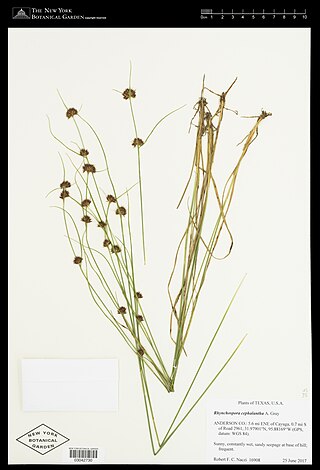
Rhynchospora cephalantha, known by the common name of bunched beaksedge, is a member of the sedge family, Cyperaceae. It is a perennial herb, found throughout the eastern United States, from New York to Texas.

Rhynchospora baldwinii, known by the common name of Baldwin's beaksedge, is a member of the sedge family, Cyperaceae. It is found in riverbanks and swampland near the coasts of the southeastern United States, as far west as New Orleans and as far north as Morehead City in North Carolina.

Rhynchospora careyana, known by the common name of broadfruit horned beaksedge, is a member of the sedge family, Cyperaceae. It is found in marshy areas near the Gulf coast of the southeastern United States, from western Louisiana to southeastern Georgia.
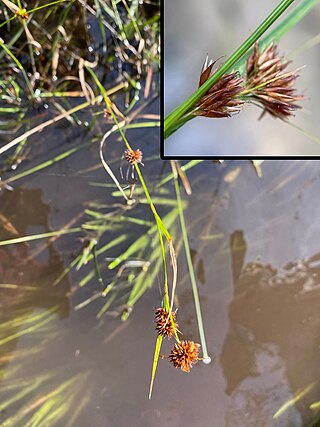
Rhynchospora chalarocephala, known by the common name of loosehead beaksedge, is a member of the sedge family, Cyperaceae. It is a perennial herb, found throughout the southeastern and Mid-Atlantic United States, from New Jersey to Texas.

Rhynchospora chapmanii, known by the common name of Chapman's beaksedge, is a member of the sedge family, Cyperaceae. It is a perennial herb, found in wetlands of the southeastern United States from North Carolina to Louisiana, as well as in Belize, Cuba, Honduras, and Nicaragua.

Rhynchospora berteroi, known by the common name of little beaksedge, is a member of the sedge family, Cyperaceae. It is a perennial herb, native to wetlands in the Caribbean islands and Belize, and also found in the southeastern United States.
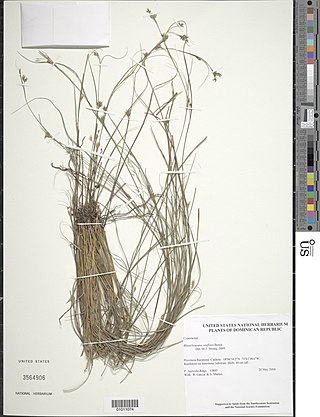
Rhynchospora biflora, known by the common name of twoflower beaksedge, is a member of the sedge family, Cyperaceae. It is a perennial herb, found in rainforests of the Caribbean, Colombia, and Venezuela, as well as southeastern Brazil.

Rhynchospora brachychaeta, known by the common name of West Indian beaksedge, is a member of the sedge family, Cyperaceae. It is a perennial herb, found in wetlands of the southeastern United States, the Caribbean, Central America, and Guyana.

Rhynchospora ciliaris, known by the common name of fringed beaksedge, is a member of the sedge family, Cyperaceae. It is a perennial herb, found in wetlands of the southeastern United States, from New Orleans to Morehead City.




















